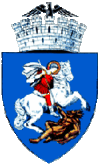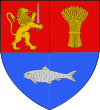Craiova
| Craiova | |||
|---|---|---|---|
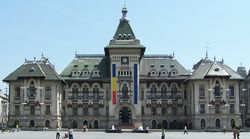 |
|||
|
|||
| Nickname(s): Bans' Citadel (Romanian: Cetatea Băniei |
|||
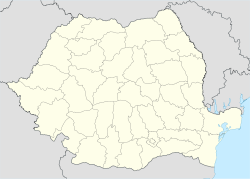 Craiova
|
|||
| Coordinates: | |||
| Country | |||
| County | Dolj County | ||
| Status | County capital | ||
| Government | |||
| - Mayor | Antonie Solomon (Democratic Party) | ||
| Area | |||
| - City | 81.4 km2 (31.4 sq mi) | ||
| - Metro | 550.1 km2 (212.4 sq mi) | ||
| Population (est. 2009[1]) | |||
| - City | 298,643 | ||
| - Density | 3,668/km2 (9,500.1/sq mi) | ||
| - Metro | 333,834 | ||
| Time zone | EET (UTC+2) | ||
| - Summer (DST) | EEST (UTC+3) | ||
| Website | http://www.primariacraiova.ro/ | ||
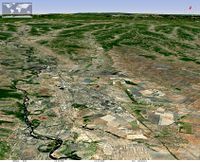
Craiova (Romanian pronunciation: [kraˈjova]), Romania's 6th largest city[1] and capital of Dolj County, is situated near the east bank of the river Jiu in central Oltenia. It is a longstanding political center, and is located at approximately equal distances from the Southern Carpathians (north) and the River Danube (south). Craiova is the chief commercial city west of Bucharest and the most important city of Oltenia. The city prospered as a regional trading centre despite an earthquake in 1790, a plague in 1795, and a Turkish assault in 1802 during which it was burned.
Eight villages are administered by the city: Făcăi, Mofleni, Popoveni, Şimnicu de Jos, Cernele, Cernelele de Sus, Izvoru Rece and Rovine.
Contents |
History
Craiova, which occupied the site of the Dacian and Roman city Pelendava, was formerly the capital of Oltenia. Its ancient bans, the highest ranking boyars of the Wallachian state, initially those of the Craioveşti family. The bans had the right of minting coins stamped with their own effigies - the origin of the Romanian word ban as used for coins.
In 1395 Craiova was probably the scene of a victory won by the Wallachian Prince Mircea I of Wallachia over Bayezid I, Sultan of the Ottomans (see Battle of Rovine).
Frequently referred to as "a city" after the first half of the 16th century, the Craiova area was always regarded as an important economic region of Wallachia and Romania at large. During the 1718-1739 Habsburg occupation of Oltenia, Craiova's status declined due to economic pressures and increased centralism, partly leading to an increase in hajduk actions, in parallel with protests of Craiovan boyars. In 1761, under Prince Constantine Mavrocordatos, the bans relocated to Bucharest, leaving behind kaymakams to represent them in Craiova.
Under Prince Emanuel Giani Ruset, Wallachia's seat was moved to Craiova (1770–1771), viewed as a place of refuge during the Russo-Turkish War of 1768-1774. A large part of the city was burned down by the rebel pasha Osman Pazvantoğlu in 1800.
During the Wallachian uprising of 1821, inhabitants of the present-day Dolj County joined Tudor Vladimirescu's Pandurs in great numbers, contributing to the expedition on Bucharest. During the first two decades of the 19th century, Craiova witnessed economic prosperity, centered on handicraft trades and public services. During Imperial Russian occupation and the early stages of Organic Statute rules (1828–1834), the city increased its economic output; in 1832 there were 595 shops, 197 made of which were barracks and 398 were houses built of brick. At the time, Craiova exported wheat, furs, leather, live animals and other products into the Austrian and Ottoman Empires.
Costache Romanescu, a citizen of Craiova, was among the leaders of the Provisional Government during the 1848 Wallachian revolution. Wallachia's last two rulers, Gheorghe Bibescu and Barbu Dimitrie Ştirbei, came from an important boyar family residing in Craiova – the Bibescu family.
Around 1860, there were 4,633 buildings in Craiova, which were 3,220 houses, 26 churches, 11 schools and 60 factories and workshops. In all, the city also housed about 90 industrial establishments, of which 12 were mills, 3 breweries, 2 gas and oil factories, 4 tanning yards and 2 printing presses; 57% of the total number of craftsmen of Dolj County lived in Craiova (1,088 craftsmen, 687 journeymen and 485 apprentices).
The period following the Independence War was a time of economic and cultural progress. As a result, at the end of the 19th century, the city of Craiova, with its 40,000 inhabitants, had developed small factories (producing chemicals, farming utilities, and construction materials) and textile factories. On October 26, 1896, the Craiova power station entered service (with AEG equipments working at 310 CP, supplying 365 streetlights on 39 streets, forming a 30 km-long network); Craiova was the first city in the country to be supplied with electric power by internal combustion engines.
In 1900, Craiova had 43.1% of the industrial units of Oltenia; these numbered 924 industrial companies (including 20 large industrial establishments, employing 1,078 workers). The number of large industrial establishments rose to 40 by 1925. Banking also developed at the beginning of the 20th century (when 6 banks and 2 bureaux de change were already operating).
In the interwar period, Craiova, as the centre of an agricultural region, experienced little further industrialization; the number of industrial workers remained comparatively small. In 1939, Craiova had 7 industrial units with over 100 workers: the clothing industry companies Oltenia and Scrisul Românesc were well-known all over the country and abroad.
In the early 1960s, under the Communist regime, the city become a noted centre for the automotive and engine building industries, as well as for aerospace manufacturing, chemical industry, food industry, construction, electrical engineering, mining and the electrical power industry.
After the 1989 Revolution brought the re-establishment of a free market and decentralisation in overall management, several industries became subject to privatisation, while the market opened itself to private initiatives. Industry, although affected by economic changes, remains an important branch, representing ca. 70% of Craiova's output
Population
According to the last Romanian census, from 2002, there were 302,601 people living within the city of Craiova, making it the sixth most populous city in Romania.
Ethnic composition:
- Romanians: 292,487 (96.66%)
- Hungarians: 218 (0.07%)
- Germans: 173 (0.06%)
- Serbs: 34 (0.01%)
- Roma: 8,820 (2.91%)
- Italians: 178 (0.06%)
- Greeks: 188 (0.06%)
- Ukrainians: 32 (0.01%)
and 471 others.
As of 2009, an estimated 298,643 inhabitants live within the city limits.[1]
Economy
During the post-Revolution period, telecommunication services, banking and insurance, management consulting (CDIMM, Romanian-American Center) began expanding. The number of joint ventures and the value of invested capital at county level have increased to large numbers — Dolj County being the first in respect to these aspects. The Automobile Craiova factory, formerly owned by Daewoo and renationalised after Daewoo's bankruptcy, was sold in September 2007 to Ford.
Of the working population (about 110,000 persons), 38% are employed in industry, 15% in trade and repair services, 10% in transport and storage, 8% in education, 5.7% in the medical field.
Transport

The public transport in Craiova consists of 3 trolley tram lines and 17 bus lines. It is operated by the Regia Autonomă de Transport Craiova (RAT Craiova), a corporation run by City Hall. One ticket is around €0.5.
Craiova is also a major railway centre and is connected to all other major Romanian cities, as well as local destinations, through the national Căile Ferate Române network. Check the national railway timetable for an appropriate connection.
The city's taxicabs are very cheap. Usually you don't pay more than €1-€2 (around €0.3/km).
The city is served by Craiova Airport.
Landmarks
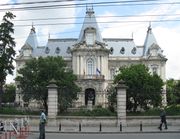
- Madona Dudu Church - built between 1750 and 1756, renovated in 1844, after being destroyed by an 1831 earthquake. Murals were completed by Gheorghe Tattarescu.
- St. Demetrius Church
- The Church of Coşuna Monastery - the oldest building preserved in Craiova, dating from 1483.
- Băniei House - the oldest non-religious building that exists in Craiova, dating from 1699. Today it hosts the Museum of Ethnography and Folk Art.
- Craiova Art Museum - the building that houses the museum was built in 1896, following the plans of the French architect Paul Gotereau. Its main attraction is the art gallery dedicated to Constantin Brâncuşi, exhibiting six of his early sculptures (including variants of his best-known works): The Kiss (1907), Vitellius (1898), Woman Torso (1909), The Vainglory (1905), Boy's Head (1906), Miss Pogany (1902).It also has a variety of paintings by leading Romanian masters such as;Theodor Aman,Nicolae Grigorescu,Vasile Popescu,Stefan Luchian,and Theodor Pallady plus some Romanian icons.
- Museum of Oltenia - founded in 1915 and divided into three sections: ethnography, history and natural science. The collection is based on donations made in 1908.
- Nicolae Romanescu Park (formerly Bibescu Park) - the largest and most well-known park in Craiova. Through the initiative of Nicolae P. Romanescu, the mayor of Craiova at that time, the park was designed by French architect Émile Rendont. Plans for the park were awarded the gold medal at the 1900 World Fair; work began in 1901 and was completed in 1903.
- Botanical Garden - The garden was laid out by the botanist Alexandru Buia and was opened in 1952. The main purpose of the garden was to facilitate the students' activities and research for the academic staff of the Agriculture and Horticulture Faculties of the University of Craiova. The Botanical Garden is organized in six areas: plant systematics, floral provinces of the globe, cultivated plants, seed beds, phyto-geography of the Oltenia region, and a greenhouse.
- Jiu Meadow
Education
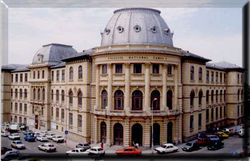
The first school in Craiova was founded in 1759 by Constantin Obedeanu. In the spring of 1826 Obedeanu's school took the name Şcoala Naţională de Limba Română which means National School of Romanian Language. This was the second Romanian high school after Saint Sava high school in Bucharest (founded in 1818).
Primary schools
- Obedeanu School
- Traian School
High schools
- Henri Coanda High School
- Carol I High School (former Nicolae Balcescu High School).
- Fratii Buzesti High School
- Elena Cuza High School
- Stefan Odobleja Computer Science High School
- Traian Vuia High School
- Nicolae Titulescu High School
- Stefan Velovan High School
Universities:
- University of Craiova
- University of Medicine and Pharmacy
Sport
Natives
- Constantin Argetoianu, former Prime Minister
- Corneliu Baba, painter
- Gheorghe Bibescu, Prince of Wallachia
- Lola Bobesco, violinist
- Adrian Cioroianu, historian, politician
- Constantin Coandă, former Prime Minister
- Nicolae Coculescu
- George Constantinescu, scientist, engineer and inventor
- Grigore Gabrielescu
- Dimitrie Gerota, anatomist and physician
- Titu Maiorescu, former Foreign Minister and Prime Minister
- Ludovic Mrazek
- Jean Negulesco, film director and screenwriter
- Petrache Poenaru, inventor of the world's first fountain pen
- Eduard Prugovečki, physicist, mathematician
- Constantin Sănătescu, former Prime Minister
- Francisc Şirato, painter
- Sabba Ştefănescu, professor of paleontology at the University of Bucharest
- Barbu Ştirbei, prince of Wallachia
- Nicolae Titulescu, the only politician ever who was president of the League of Nations two times: 1930 and 1931
- Ion Ţuculescu, painter
- Nicolae Vasilescu-Karpen, engineer, pioneer in telegraphy and telephony
- Varujan Vosganian
- Diana Dondoe, international supermodel
Politics
The Craiova Municipal Council, elected in the 2004 local government elections, is made up of 27 councillors, with the following party composition:
| Party | Seats | Current Council | ||||||||||||
|---|---|---|---|---|---|---|---|---|---|---|---|---|---|---|
| Social Democratic Party | 12 | |||||||||||||
| Justice and Truth Alliance | 8 | |||||||||||||
| Greater Romania Party | 4 | |||||||||||||
| Conservative Party | 2 | |||||||||||||
| Independents | 1 | |||||||||||||
International relations
Twin towns — Sister cities
References
- Istoria Craiovei, Titu Georgescu, Constantin Barbacioru, Florea Firan, Virgil Joita, Constantin Mocanu, Luchian Deaconu, Ion Dogaru, Editura Scrisul Românesc, 1977
- Florea Firan, Alexandru Firescu, Craiova , Ghidul oraşului, Editura Sport-Turism, 1982
- Documentare statistică privind evoluţia economică şi socială a municipiului Craiova, Dolj County Statistical Office, 1992
External links
- Craiova
- Craiova Forum
- (Romanian) Census 2002: Craiova
- University of Craiova
- University of Medicine and Pharmacy of Craiova
- Musical Fountain of Craiova
- The Old Craiova in images
- Craiova Map
- Cazare Craiova, Cazare Craiova
- tram in Craiova
Notes
- ↑ 1.0 1.1 1.2 "Largest cities in Romania" (in Romanian). Agerpres. February 2, 2010. http://www.agerpres.ro/english/index.php/component/k2/item/173.html. Retrieved June 13, 2010.
- ↑ "Partner Cities of Lyon and Greater Lyon". © 2008 Mairie de Lyon. http://www.lyon.fr/vdl/sections/en/villes_partenaires/villes_partenaires_2/?aIndex=1. Retrieved 2009-07-17.
|
|||||||||||||
|
|||||||
